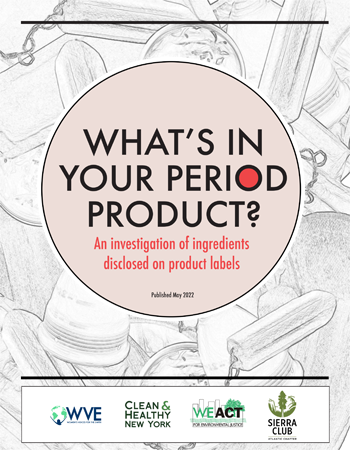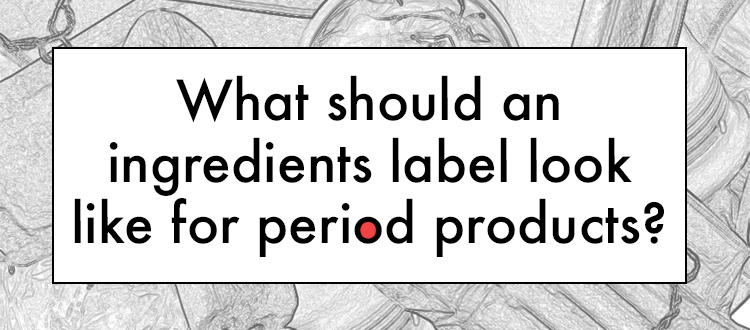 May 2022
May 2022
REPORT
Español – ¿Qué existe en su producto para la menstruación? Una investigación de los ingredientes divulgados en las etiquetas de los productos.
What’s in Your Period Product?
An investigation of ingredients disclosed on product labels
Executive Summary:
Period products are used on and in highly sensitive and absorptive parts of our bodies, which makes it important to understand the potential chemical exposures associated with their use. Until recently, information about ingredients, components or additives used in period products was largely unavailable from manufacturers. Chemical testing in the last ten years raised concerns as toxic volatile organic compounds, phthalates, and other chemicals of concern have been identified in these products. But, efforts to better understand these chemical exposures from specific period products (or to identify safer alternatives) were hampered by the general lack of ingredient information from manufacturers. Over the last few years, however, there have been significant advances in ingredient transparency in the period product industry. As a result of market campaigns and clearly expressed user demand, manufacturers gradually began voluntarily providing more information about what these products were made of. Then, in 2019 the New York State legislature passed the first law in the country requiring disclosure of all intentionally added ingredients in period products on the label – a law which went into effect in October 2021. This law specifically includes disclosure of ingredients in any products used to collect or absorb menstrual discharge including (but not limited to) tampons, pads, menstrual underwear, menstrual cups, and discs. From November 2021 – February 2022, Women’s Voices for the Earth (WVE) conducted a field study examining ingredient disclosures on period product labels both in New York and across the United States. This report examines the findings of that field study.
Main Findings:
- Ingredient information is now standard on period product packages – this is a significant change in 2021 compared to just a year prior. More information is available on chemical exposures from period products in the U.S. than ever before.
- Numerous additives to period products are now being disclosed for the first time, indicating that chemical exposure from period products is much more complicated than previously assumed.
- There are ingredients newly disclosed in period products – which are of concern to users – including chemicals which can cause skin irritation, cause allergic reactions, which may contain toxic contaminants that can cause cancer, and which release microplastic particles into the environment.
- Compliance with the NY law is not perfect. A few products evaluated in this field study were found not to disclose ingredients at all. More frequently, compliance with the labeling law was incomplete, with only vague descriptions of ingredients disclosed. We found that actual chemical names of ingredients were commonly omitted, with descriptions of ingredient functions such as “fragrance”, “adhesive”,“surfactant” or “ink” disclosed instead. The intentionally added ingredients which provide for these functions must be disclosed in compliance with the NY law.
- All manufacturers have room to improve to provide useful ingredient information to their customers. The ideal period product ingredient disclosure should include the chemical name and function of the ingredient, and the component of the product where the ingredient can be found.
- The NY law is having a national impact. We commonly found products in other states with ingredient disclosures on the package similar or identical to what is required in New York, affording period product users across the country the right to know what is in their products.
Conclusion:
The NY law requiring ingredient disclosure for period products is providing new and important ingredient information about chemical exposures from the use of these products for the first time. This new information opens the door to better understanding the health and environmental impacts of these products, and to improving them over time. But compliance with the law thus far is not perfect. Many manufacturers still must work to be in compliance with the law, which means providing consumers with complete information on ingredients used in their products. With better ingredient information, users of these products will be better able to choose the products that work best for their bodies, while avoiding exposures that may cause health impacts or environmental impacts of concern. Manufacturers will be better able to respond to the needs of their customers, and to innovate safer and healthier products. And scientists will be better able to conduct the long overdue research to examine the long term health and environmental impacts of these products.





